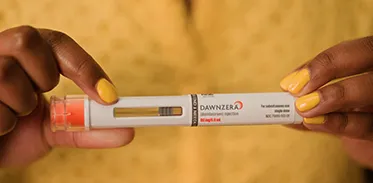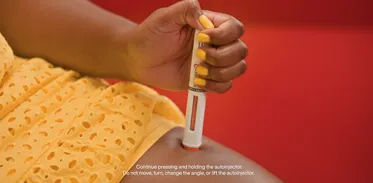

The longest time between doses approved for HAE
DAWNZERA offers the longest time between doses available for hereditary angioedema (HAE) attack prevention with a convenient autoinjector.*
Dosing done differently
DAWNZERA offers the convenience of a self-administered autoinjector. No mixing or syringes, and although refrigeration is recommended, it can be stored at room temperature for 6 weeks.
Dosing every 4 or 8 weeks
Recommended dosing for DAWNZERA is once every 4 weeks and every 8 weeks may also be considered.
Autoinjector
DAWNZERA is delivered through an autoinjector. DAWNZERA contains no citric acid, which is associated with injection-site pain.†
Flexible storage
DAWNZERA autoinjectors can be stored in their original cartons at room temperature (up to 86 °F [30 °C]) for up to 6 weeks.
Please note: Do not expose your DAWNZERA autoinjector to heat, do not freeze it, and protect it from direct light.
*Available in every-4-week and every-8-week dosing.
† In clinical studies, injection-site reactions, including injection-site pain, were the most frequently reported adverse reactions.
Step-by-step support for taking DAWNZERA
DAWNZERA is delivered through a convenient, single-use autoinjector, and a few quick steps can help you feel confident you’re doing it right. Watch the How to Use DAWNZERA video to learn how you’ll receive and administer your treatment.


Chapter selection

PATIENT: I have hereditary angioedema, or HAE, and recently flipped the switch to DAWNZERA for my HAE preventative treatment. So, what’s next for me? Making sure I know how to do my treatments from the comfort of here, or here, or here, or wherever I may be. Oh hey…who are you?
LISSETTE: I’m Lissette, your personal Patient Education Manager. You signed up for Ionis Every Step™, so, I’m here to help you every step of the way.
PATIENT: Nice! One-on-one attention. Should we get started?
LISSETTE: Mmhm
PATIENT: Okay, first things first — I’m not always at home.
LISSETTE: That’s fine, you don’t always need to be at home. DAWNZERA can fit into your routine as long as you follow the instructions.
PATIENT: Can everyone inject DAWNZERA the same way?
LISSETTE: Yes!
PATIENT: Woah! Okay!
LISSETTE: With DAWNZERA, your doctor will decide your dosing. It could be once every 4 weeks or 8 weeks. But the way you take DAWNZERA is the same no matter which dosing option your doctor decides for you.
PATIENT: Perfect, I’m feeling good to get started. Let’s learn how to inject DAWNZERA.
LISSETTE: Okay, first let’s take a look at the autoinjector.
PATIENT: Already got it! And I’ve taken it out of the fridge, and it’s been at room temperature for 30 minutes as recommended.
LISSETTE: Under this clear cap is the orange needle shield. The needle shield covers the needle when not in use.
PATIENT: Hm, okay. So, what’s this?
LISSETTE: That’s the rubber needle shield. This will also be removed with the cap. Here’s the viewing window and the plunger.
PATIENT: Oh, so the medicine is inside. How do I actually use it?
LISSETTE: Your doctor should have shown you how to inject DAWNZERA—or you may have practiced with the demonstration autoinjector from your welcome kit. But let's review the steps together.
PATIENT: Wait! Let me prepare first! I know you need a sharps container for safe disposal.
LISSETTE: Don’t forget an alcohol wipe, a cotton ball or gauze, and a small bandage too.
PATIENT: Right, thank you! Okay, I’m ready.
LISSETTE: We’ll always begin by taking the autoinjector out of the carton.
PATIENT: Easy peasy. Got that covered.
LISSETTE: Make sure the expiration date hasn’t passed, then check the medicine through the viewing window. It should be clear and colorless to yellow. Don’t use if the medicine looks cloudy or discolored. There should be no particles, but it is normal to see air bubbles in the solution.
PATIENT: All clear!
LISSETTE: Don’t use the autoinjector if it is expired, appears damaged, or if the clear cap is missing, or not attached.
PATIENT: All good. Can I inject now?
LISSETTE: Not quite yet—first we have to choose where to inject. You’ll want to pick a spot on your stomach or the front of your thigh.
PATIENT: I think I’d feel more comfortable with the thigh.
LISSETTE: No problem, but if you choose your stomach in the future, be sure to pick a spot at least two inches away from your belly button.
PATIENT: Okay…is there anywhere else I can inject it?
LISSETTE: Well, the back of the arm can also be an injection site, but only for care partners, since this area can be hard to reach alone. It’s also important not to inject into scars or damaged skin, including any skin that is bruised, tender, red, or hard.
PATIENT: Okay, looks like I’m ready then! Let me just wash my hands…wipe clean my injection site…
LISSETTE: Don’t forget to wait a few seconds to allow the area to air dry before you begin to inject.
PATIENT: Good to go!
LISSETTE: First, it’s important to remember not to remove the cap until you’re ready to inject. Once the cap has been removed you cannot recap the autoinjector.
PATIENT: Got it.
LISSETTE: Now, we’ll start by holding the autoinjector by the middle, with the clear cap facing away from you. Remove the cap by pulling it straight off. Don’t twist it, and don’t push the orange needle shield against your hands or fingers. The needle is under there.
PATIENT: Say no more. I won’t go near there. I think I remember what’s next, my doctor said, "PLACE, PUSH, HOLD?"
LISSETTE: That’s right! Using one hand, PLACE the orange needle shield at a 90-degree angle against your skin. Make sure you can see the viewing window.
LISSETTE: Position the autoinjector straight against the skin and PUSH firmly.
PATIENT: There’s no button?
LISSETTE: Nope, just push down the entire autoinjector and hold for 10 seconds. You will hear a click as the injection starts. It’s normal to hear a second click, but that doesn’t mean the dosing is finished. Do not move or lift the autoinjector, this could result in you not receiving your full dose.Now, HOLD and continue pressing the autoinjector in place for 10 seconds to make sure the full dose has been given. No twists, no turns, just keep it steady.
PATIENT: Does the music come with the autoinjector?
LISSETTE: No, but you can sing the “Happy Birthday” song as a reminder to hold in place for 10 seconds. Now we can check the viewing window.
PATIENT: Yup, looks like that plunger rod has filled the entire window.
LISSETTE: Great. If it hasn’t, that means you may not have received the full dose. Contact your doctor if this happens. Remove the autoinjector by lifting it straight up—put the used autoinjector in the sharps container, not the trash, right after use. Never reuse the autoinjector or clear cap. After the injection, a small amount of blood or medicine may be present on your skin. If needed, add pressure with a cotton ball or gauze and apply a small bandage.
PATIENT: That’s why we always come prepared.
LISSETTE: That’s it! You’re done.
PATIENT: So, when I get my next autoinjector, can I store it anywhere?
LISSETTE: Well, you’ve flipped the switch to the DAWNZERA autoinjector. It’s recommended you keep it in the fridge.
PATIENT: Does it always need to stay in the fridge?
LISSETTE: Nope! DAWNZERA can be stored in its original carton at room temperature for up to six weeks.
PATIENT: Great, more room for my snacks!
LISSETTE: Just don’t expose DAWNZERA to heat or freeze it. Don’t forget to let the carton sit at room temperature for 30 minutes before injecting.
PATIENT: Noted...well let's not stand around!
LISSETTE: Alright, moving on.
PATIENT: This was so great Lissette. I wish I had you around for all my questions about my treatment journey.
LISSETTE: You do! That’s what your Patient Education Manager is here to do.
PATIENT: Okay, don’t be surprised if I call tomorrow then. I could use some help understanding my insurance too.
LISSETTE: Of course, that’s what I’m here for. Everyone who signs up for Ionis Every Step gets their own personal Patient Education Manager and support resources to help stay on track.
PATIENT: Wow, you’re always there, like a helpful neighbor or something. You wouldn’t happen to have some sugar I could borrow too?
LISSETTE: [Laughs]
INDICATION
DAWNZERA™ (donidalorsen) is a prescription medicine used to prevent hereditary angioedema (HAE) attacks in adults and children 12 years of age and older.
It is not known if DAWNZERA is safe and effective in children under 12 years of age.
IMPORTANT SAFETY INFORMATION
Do not use DAWNZERA if you have had a serious allergic reaction, including anaphylaxis to donidalorsen or any of the ingredients in DAWNZERA.
Before using DAWNZERA, tell your healthcare provider about all of your medical conditions, including if you: are pregnant or plan to become pregnant, are breastfeeding or plan to breastfeed. It is not known if DAWNZERA can harm your unborn baby, or if it passes into your breast milk and if it can harm your baby.
Tell your healthcare provider about all the medicines you take, including prescription and over-the-counter medicines, vitamins, and herbal supplements.
What are the possible side effects of DAWNZERA?
DAWNZERA can cause serious side effects including allergic reactions. Allergic reactions can include rash, trouble breathing, chest pain, fainting, dizziness, feeling lightheaded, swelling of the face, lips or tongue, and itching. Stop using DAWNZERA and call your healthcare provider or get emergency help right away if you have any of these symptoms.
The most common side effects of DAWNZERA include injection site reactions (such as redness or pain at the injection site), upper respiratory tract infection, urinary tract infection, abdominal discomfort.
These are not all the possible side effects of DAWNZERA. Tell your healthcare provider or treatment team about any side effects you may have.
You are encouraged to report negative side effects of prescription drugs to the FDA. Visit www.fda.gov/safety/medwatch, or call 1-800-FDA-1088.
Please see full Prescribing Information and Patient Information for DAWNZERA, also available at dawnzera.com.

If your autoinjector is in the fridge, remove it. Keep the autoinjector in the original carton and let it come to room temperature for 30 minutes before injecting.
The solution should be clear and colorless to yellow. There should be no particles. It is normal to see air bubbles in the solution.

Choose an injection site on the stomach or the front of the thigh. If a caregiver is helping you, the back of the upper arm can also be chosen.
Wash your hands with soap and water. Clean the injection site with an alcohol wipe in a circular motion. Let the skin air dry.
Do not touch the cleaned skin before injecting.

Remove and throw away the clear cap. Place the orange needle shield at a 90-degree angle against your skin. Push firmly and hold the autoinjector straight against the skin. You will hear a click as the injection starts.
You may hear a second click. This is normal. The procedure is not finished.
Hold the autoinjector against the skin for 10 seconds to make sure the full dose has been given. Remove the autoinjector by lifting it straight up.
Put the used autoinjector in a sharps container after use.
